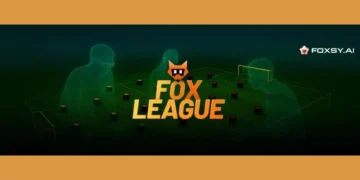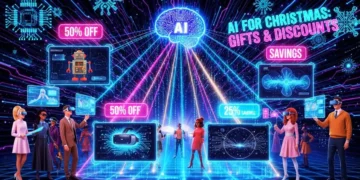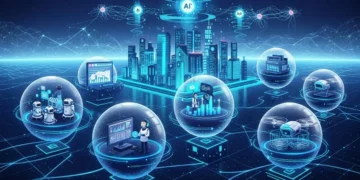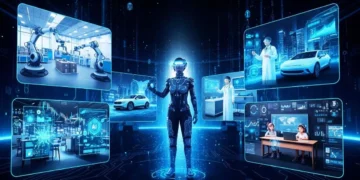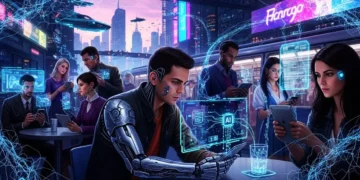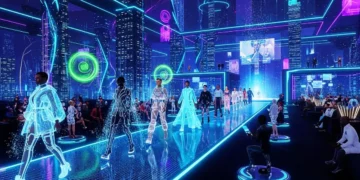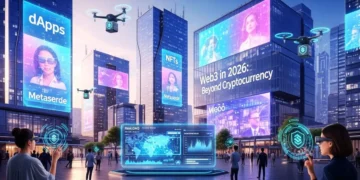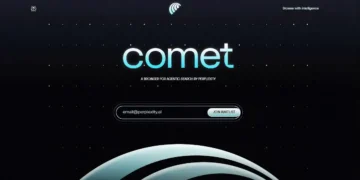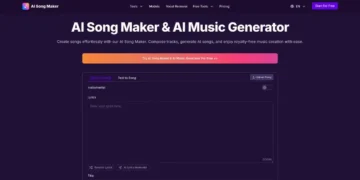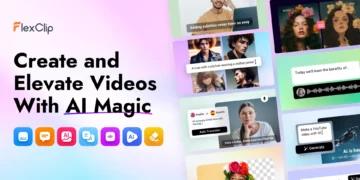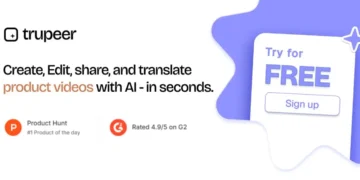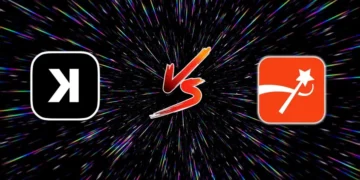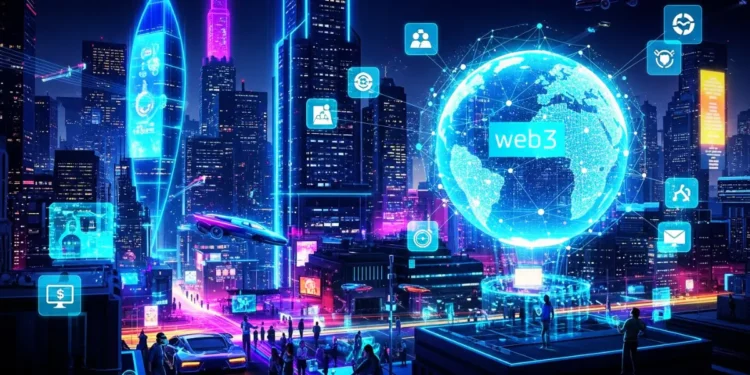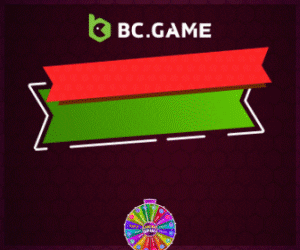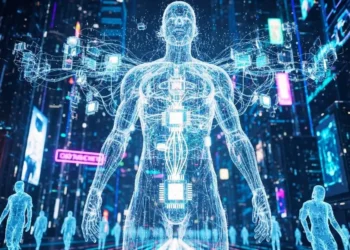Imagine an internet where you truly own your digital life—your photos, your financial history, your online identity. Not a corporation that can delete your account, change the rules overnight, or profit from your personal data without your consent. Does this sound like a fantasy? This is the fundamental promise of Web3, the next evolution of the internet, and it’s already taking shape around us.
By 2030, the global Web3 market is projected to reach a staggering $33.53 billion, growing at a phenomenal compound annual growth rate of 49.3% from 2024 to 2030 . This isn’t just about cryptocurrency prices; it’s about a foundational shift from a centralized web (Web2) to a decentralized internet built on blockchain technology. This new paradigm aims to return power, privacy, and ownership to users.
But what does this technological shift actually mean for your daily routine? How will Web3 technology tangibly impact how you bank, socialize, work, and play? This article will explore the surprising and practical ways the decentralized web will reshape our everyday lives by the end of this decade. We’ll move beyond the hype to uncover the real-world applications of Web 3.0 that are set to create a more transparent, user-centric, and equitable digital world. Ready to see the future?
What is Web3? A Quick Refresher
Before we dive into the future, let’s quickly level-set. If you’re asking, “What is the future of Web3?” you first need to understand what it is.
Web1 (The Read-Only Web): The early internet was a collection of static web pages. You could read information, but interaction was minimal .
Web2 (The Read-Write Web): This is the internet we know today. It’s dynamic and social, dominated by platforms like Facebook, Google, and Amazon. You can create content and interact, but these central corporations own your data, control the platform, and capture most of the value .
Web3 (The Read-Write-Own Web): This is the next iteration. Web3 technology leverages blockchain to create a decentralized internet. No single entity has absolute control. Instead, users own their data, digital assets, and identities through cryptographic keys. It’s a vision for a more open, democratic, and user-owned digital world .
The core features driving this change are decentralization, blockchain-based transparency, and user empowerment. But how do these principles translate from abstract concepts into real-world tools?
The Explosive Growth of the Web3 Market
The market value of Web3 is projected to skyrocket to approximately $81.5 billion by 2030, reflecting a compound annual growth rate (CAGR) of 49.3%. This tremendous growth is fueled by sectors like decentralized finance (DeFi), blockchain gaming, AI-powered decentralized applications (dApps), and tokenization of assets.
Current market size is around $27.5 billion and expanding rapidly.
The Web3 economy is set to contribute $1.1 trillion to the global GDP by 2032.
Blockchain tokenization could represent 10% of global GDP by 2030.
The metaverse economy, closely linked with Web3, may exceed $5 trillion in value.
Does the idea of an exploding Web3 ecosystem excite you as much as the prospect of financial and digital empowerment?
How Will Web3 Impact Our Lives?
Enhanced Data Ownership and Privacy
One of the most immediate benefits of Web3 is user-centric data ownership. Instead of handing over personal information to corporate giants, users own and control their data through decentralized identities. This means greater privacy and security, significantly reducing risks like data breaches or unauthorized data sales.
Smarter and Seamless Connectivity
Thanks to the integration of AI, IoT, and blockchain, Web3 will enable smarter devices and online systems that understand context and user preferences better. This improved interoperability will enhance everyday experiences, from personalized shopping to efficient healthcare solutions.
Revolutionizing Finance and Commerce
Decentralized finance (DeFi) is disrupting traditional banking by enabling peer-to-peer transactions without intermediaries. By 2030, the DeFi market capitalization could rise from $20 billion today to over $230 billion, making financial services more accessible and inclusive worldwide.
New Digital Experiences through Gaming and the Metaverse
Web3 is transforming gaming by integrating blockchain for asset ownership and transparent transactions. Combined with the metaverse, these innovations will offer immersive virtual realities where users not only play but own digital assets and experiences.
Are you curious about how owning digital collectibles or virtual real estate could become part of your lifestyle?
Web3’s Role in Sustainability and Social Impact
Beyond technology and finance, Web3 is poised to support sustainable development goals through transparent supply chains and decentralized governance models. It offers tools for governments and organizations to work more openly and efficiently, promoting social equity and environmental responsibility.
The Key Technologies Powering the Web3 Revolution
The future of Web3 is being built today on a foundation of powerful, interoperable technologies. Understanding these building blocks is key to seeing how profound the coming changes will be.
Table: Core Web3 Technologies and Their Functions
| Technology | Primary Function | Real-World Analogy |
|---|---|---|
| Blockchain | A decentralized digital ledger that records transactions immutably and transparently. | A shared community record book that everyone can trust, with no single person in charge. |
| Smart Contracts | Self-executing contracts with terms written directly into code, automating agreements without intermediaries. | A digital vending machine: you put in a crypto coin, and it automatically dispenses a product without needing a shop assistant. |
| Decentralized Identity (SSI) | Allows individuals to own and control their personal information without relying on centralized authorities. | A digital passport that you carry in a secure wallet, choosing what information to share and with whom. |
| Decentralized Physical Infrastructure (DePIN) | Uses crypto-incentives to build real-world infrastructure (wireless, storage) owned by participants. | A community-owned garden where contributors are rewarded with tokens for their work, instead of a corporate farm. |
Surprising Ways Web3 Will Reshape Your Daily Life by 2030
So, how will Web3 technology move beyond whitepapers and into your wallet, your home, and your workplace? Let’s explore the tangible changes on the horizon.
1. Your Wallet Becomes Your Bank: The DeFi Revolution
How do you think Web3 will change the web as we know it? For many, the first and most profound impact will be on their finances. Decentralized Finance (DeFi) is set to revolutionize the financial sector by offering services without traditional intermediaries like banks.
By 2030, the DeFi market size is expected to grow from $20.48 billion in 2024 to an astonishing $231.19 billion . This growth will manifest in your daily life through:
Peer-to-Peer Lending and Borrowing: Imagine getting a loan directly from a pool of other individuals, with terms enforced by smart contracts, potentially offering you better interest rates than a traditional bank .
Borderless Payments: Sending money internationally could become as easy and instant as sending an email, with minimal fees, thanks to blockchain-based systems .
New Investment Avenues: Tokenized assets—where real-world assets like real estate or art are represented digitally on a blockchain—will make investing more accessible and fractionalized .
The impact on our lives here is massive: greater financial inclusion, lower costs, and more personal control over our money.
2. True Digital Ownership: Beyond Just NFTs as Art
When people hear NFTs, they often think of expensive digital art. But the real future of Web3 and NFTs is about verifiable ownership of virtually anything.
Gaming: In the future, when you buy a skin, weapon, or character in a Web3 game, you will truly own it as an NFT. This means you can trade it, sell it on open marketplaces, or even use it across different compatible games, creating a player-driven economy . The Web3 gaming market is anticipated to be worth over $65 billion by 2027 .
Event Tickets and Loyalty Programs: Your concert ticket or airline loyalty points could be issued as NFTs, eliminating fraud and allowing you to potentially trade or resell them transparently.
Real-World Asset Tokenization: This is a huge one. How will Web 3.0 impact our lives? It could allow for the fractional ownership of a building or a rare physical collectible, opening up investment opportunities that were previously reserved for the ultra-wealthy .
3. Taking Back Control of Your Identity
In the current web, your digital identity is fragmented across dozens of platforms. Web3 technology offers a solution: Self-Sovereign Identity (SSI).
This concept gives you a unified, portable digital identity that you control. Your credentials—like your driver’s license, university degree, or professional certifications—can be issued as verifiable credentials on the blockchain . The impact on our lives?
No more forgetting passwords for every site.
Instant and secure verification when applying for a job or a loan.
You decide what personal data to share and with whom, drastically reducing identity theft and data brokerage.
4. Transparent and Efficient Supply Chains
Ever wondered if the “organic” food you bought is truly organic, or if the luxury handbag is genuine? Web3 technology will make supply chains radically transparent.
By recording a product’s journey from origin to shelf on an immutable blockchain, you will be able to scan a QR code and see its entire history. This reduces fraud, ensures ethical sourcing, and improves food safety. For instance, Walmart has already used blockchain to reduce food safety investigations from weeks to just 2.2 seconds .
5. Community-Owned Platforms and DAOs
How do you think Web3 will change the web as we know it? It will redefine how we organize and collaborate. Decentralized Autonomous Organizations (DAOs) are community-led entities governed by smart contracts and member votes, not a top-down hierarchy .
By 2030, we could see:
Social Media DAOs: Imagine a social platform like Facebook, but owned by its users. Decisions about content moderation, algorithm changes, and revenue sharing are made collectively.
Investment DAOs: Groups of people pooling funds to invest in startups or real estate, with transparent governance. There are already over 12,000 DAOs managing treasuries worth more than $25 billion .
Challenges on the Road to 2030: The Hurdles for Web3
The future of Web3 is bright, but the path isn’t without obstacles. For mass adoption to occur, several significant challenges must be addressed:
Scalability and User Experience: Current blockchains can be slow and expensive. Transaction fees (gas fees) and complex processes like managing seed phrases are major barriers for the average user. The technology needs to become as seamless as using a Web2 app .
Regulatory Uncertainty: Governments worldwide are still grappling with how to regulate cryptocurrencies, DeFi, and DAOs. Clear and sensible regulations are crucial for protecting consumers and encouraging institutional investment .
Energy Consumption and Environmental Impact: While many newer blockchains are moving to more energy-efficient consensus mechanisms, the public perception of blockchain as an energy hog remains a hurdle that the industry must continuously work to overcome.
The Future is Hybrid: A Blended Digital World by 2030
Will the centralized web just disappear by 2030? Unlikely. The most probable outcome is a hybrid future where centralized and decentralized systems coexist and even integrate .
You might use a traditional bank app that also offers access to DeFi yield-generating products. A major corporation like Starbucks might use NFT-based loyalty programs on a private blockchain. This blended approach allows for a smoother transition, leveraging the strengths of both models—the user-friendliness of Web2 and the ownership and transparency of Web3 technology.
Conclusion
The decentralized internet is not a distant sci-fi concept. It’s a growing reality that promises to return data ownership and digital sovereignty to individuals. The Surprising Ways Web3 Will Change Everyday Life by 2030—from how we manage our money with DeFi to how we prove our identities and own our digital assets—point toward a more equitable and user-powered digital ecosystem.
The transition will have its challenges, but the trajectory is clear. The global Web3 market is on a explosive growth path, and its impact on our lives will only deepen. The question is no longer if Web3 technology will become mainstream, but how we will choose to shape it.
What do you want your digital future to look like? The tools are being built. Now is the time to learn, explore, and participate in building a better internet.
Frequently Asked Questions (FAQs)
What will Web3 be valued at by 2030?
The global Web3 market is projected to reach $33.53 billion by 2030, according to a comprehensive industry report by Grand View Research. Other estimates are even more bullish, with some projections suggesting the market could grow as high as $229.15 billion by 2034, reflecting the immense growth potential and investor confidence in this sector .
How will Web 3.0 impact our lives?
Web 3.0 will have a profound impact on our lives by shifting control from large tech corporations to individual users. You will have true ownership of your digital data, assets, and identity. This will translate into more transparent financial systems (DeFi), verifiable ownership of digital and physical items (NFTs), more secure and portable digital identities, and community-owned platforms (DAOs) that align incentives with users, not just shareholders .
What is the future of Web3?
The future of Web3 is expected to be characterized by mainstream adoption of decentralized solutions, though likely in a hybrid model that integrates with existing Web2 services. It will deeply intertwine with other emerging technologies like Artificial Intelligence (AI) and the Internet of Things (IoT), creating smarter and more efficient systems. The focus will be on solving current challenges around scalability, user experience, and regulatory clarity to enable a more open, democratic, and user-centric internet .
How do you think Web3 will change the web as we know it?
Web3 will change the web by fundamentally rewiring its underlying structure and economic model. It will evolve the internet from a “read-write” model controlled by a few companies to a “read-write-own” model powered by its users. This means the web will become less of a walled garden where platforms profit from your data, and more of a collaborative space where users are stakeholders, privacy is enhanced by design, and trust is established through transparent code rather than centralized brand names .
